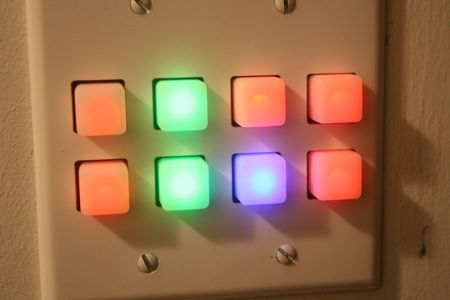This is some beautiful work. The clip features multiple video streams stabilized and then assembled into a whole. First, [ibftp] used the “Stabilize” feature in Motion 3 (part of Apple’s Final Cut Studio 2) to remove the camera shake from the clips. Then he was able to blend the videos with “fusion” set to “multiplication”. If you’ve got access to the tools, this shouldn’t be too hard to do yourself. We’re certain someone in SIGGRAPH is already attempting to do the same thing live. If you want to see image stabilization really making a difference, have a look at the stabilized version of the Zapruder film embedded below.
Day: June 12, 2008
LED Lightbar Controller
[youtube=http://www.youtube.com/watch?v=6ihIaNN9UBY&hl=en]
[Adam Grieg] recently posted this video of his LED lightbar controller at work making a strip of LEDs flash to the beat of his music. The controller does it by picking up the music via an electret microphone, then amplifying it with an LM386 Amp. The ATtiny13 microcontroller keeps track of the noise level and makes the LED array flash whenever it senses a peak.
In addition to the parts listed, [Grieg] used a small SparkFun box as the enclosure for the controller. If you’re considering trying your hand at this project, check out [Grieg]’s schematics and code. It’s relatively cheap to make, so it wouldn’t be that hard to rig up several of these set to flash at different frequencies.
[via SparkFun]
How-To: Make An RGB Combination Door Lock (Part 1)

Part 2 can be found here
Putting a custom designed electronic lock on your space seems like a geek right of passage. For our latest workspace, we decided to skip the boring numbered keypad and build a custom RGB backlit keypad powered by an Arduino. Instead of typing in numbers, your password is a unique set of colors. In today’s How-To, we’ll show you how to build your own and give you the code to make it all work.
Continue reading “How-To: Make An RGB Combination Door Lock (Part 1)”
Accelerometer Mouse From Scratch

[Mahavir] sent in his group’s final project for the College of Engineering in Pune (it’s over here). They built an accelerometer based Bluetooth mouse. They ended up creating a mouse that maps rotational movements to x/y motion. From the video movement, it strikes us as responding the same way that touch pointer mice do. You can hit the demo video after the break or get more details from the project page. Even if you’re not into the mouse idea, you can probably learn something from their Bluetooth implementation.











